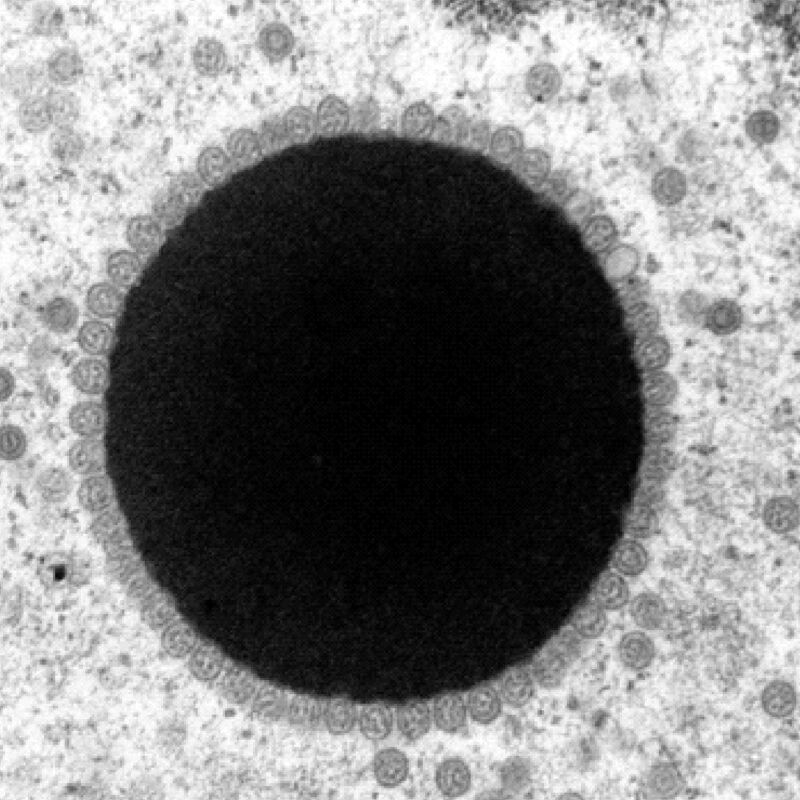
One of the defining features of viruses is that they rely on host proteins in order to reproduce. A host cell will often copy viral genes into RNAs and then translate those RNAs into proteins, for example. Typically, a mature virus that's ready to spread to another cell has little more than viral proteins, the virus's genetic material, and maybe some of the host's membrane. It doesn't need much else; all the proteins it needs to reproduce further should be present in the next cell it infects.
But some data released this week may have found an exception to this pattern. Members of the herpesvirus family appear to latch on to a protein in the first cell they infect and then carry this protein along with them to the next cell. This behavior might be helpful because of the normal targets of herpesviruses—neurons, which have a very unusual cell structure.
A long way to the nucleus
Like other viruses, herpesviruses start off by infecting cells that are exposed to the environment. But from there, they move on to nerve cells, where they take up residency, persisting even when there's no overt indications of infection. These infected cells then serve as a launching point for re-establishing active infections, causing lifetime problems for anyone unfortunate enough to have been infected.
To establish this sort of latent infection, the herpesvirus has to take up residency in a cell's nucleus. And that can be a long way from the site of infection, as nerve cells can send out lengthy extensions called axons that allow them to communicate across different areas of the body. The longest of these axons can be over a meter, so if the virus enters the neuron at the far end of the axon, it needs to travel a long way in order to reach the nucleus.
Of course, the cell itself has to move things down these long axons, so it has a system to manage that. Proteins form long fibers that run the length of the axon; other proteins (called motors) can latch on to these fibers and transit up or down the axon, hauling cargo as they go.
Herpesviruses have evolved to take advantage of this system. The virus encodes a protein that's incorporated into its shell, and it has the ability to latch on to one of the motors. So once it infects a nerve cell, it can be carried down the length of the axon like it was just another bit of cargo. As a result, the cell does much of the work needed for the virus to take up residency.
A roadblock
In the new study, a group of US-based researchers was looking at the protein the virus uses to hitch a ride on the motor proteins. Previous work had shown that the protein could latch on to two different types of motors (dynein and kinesin, for those of you up on these things), and the researchers were interested in seeing how the protein interacted with kinesin. So they figured out where in the viral protein the interaction took place.
Turning to the viral gene that encodes this protein, they made mutations that eliminated its ability to grab on to kinesin. Viruses carrying these mutations were no longer able to spread once they infected a cell. This was a bit of a surprise, given that they should still be able to latch on to the second motor protein.
To get a better sense of what was going on, the researchers grew the virus in nerve cells that lacked kinesin. The virus readily moved down the axons, presumably due to its interactions with the other motor. But once it got into the body of the cell, the virus piled up near the nucleus but wasn't able to enter it efficiently.
But there's a big difference between the low efficiency seen in this experiment and the complete absence of infection when the protein was mutated. The explanation for this difference: the virus actually carries kinesin with it from the first cell it infects.
This was very hard to detect, but the researchers eventually figured out a way. They tagged kinesin with an enzyme that would cause a chemical to change color. They then showed that cells infected with the virus would also change color, indicating that the virus could carry the tagged kinesin into the cells.
The bottom line
Putting this all together, it seems that the virus hijacks the host's transportation system in two ways. One of its own proteins can latch on to a motor that carries the virus down a nerve system's axon and gets it near the nucleus. That same protein also grabs a second motor and brings it into the cell with it. This motor allows the virus to make the transition from "near the nucleus" to "inside it."
Given that nerve cells also have their own kinesin, it's not clear why this is needed—something the authors themselves recognize and are probably working on. But the bigger question is whether viruses carrying host proteins around is more common than thought. Given how hard it was to detect this process at work in the herpesvirus, it's possible that it also happens in other well-studied viruses, but we've just missed it so far.
Nature, 2021. DOI: 10.1038/s41586-021-04106-w (About DOIs).
"use" - Google News
November 21, 2021 at 10:00PM
https://ift.tt/3cxf6bR
Herpesviruses steal one cell’s protein, use it to infect another - Ars Technica
"use" - Google News
https://ift.tt/2P05tHQ
https://ift.tt/2YCP29R
Bagikan Berita Ini














0 Response to "Herpesviruses steal one cell’s protein, use it to infect another - Ars Technica"
Post a Comment